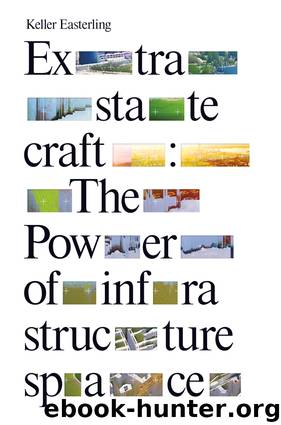Extrastatecraft by Keller Easterling

Author:Keller Easterling
Language: eng
Format: epub
Publisher: Verso Books
CHAPTER 4
Stories
For many historians, the first meeting of the International Telegraph Union (ITU) in Paris in 1865 may be worthy of no more than an obscure technical footnote. Telegraph networks had been growing throughout Europe, prompting the need for international protocols regarding, among other things, currency, tariffs, the Morse telegraph platform, and use of the French language. The tedious proceedings lasted from March 1 to May 17, but the chairman, French Minister of Foreign Affairs M. Drouyn de Lhuys, was nevertheless excited. He likened the convention to a “Peace Conference” intended to prevent the misunderstandings that are often the cause of war. Telecommunications historian Anton Huurdeman has noted that it “was the first international agreement concerning most of Europe since the Peace of Westphalia in 1648.”1 The ITU, recognizing national rather than private entities as members, only convened representatives of European nations. Even though the transatlantic cable had been in the water since 1856, the United States, then in the final stages of Civil War, did not attend the conference because its telegraph operations were commercially organized.
The delegates at the convention posed for a stiff group photograph that was considerably drier than the history painting commemorating the Peace of Westphalia at the end of the Thirty Years’ War. The ITU had actually come together not so much as diplomats to sign a peace treaty, but as delegates sorting out a number of seemingly innocuous technical expediencies. Still, the members arguably represented a new sort of power emerging at the end of the nineteenth century—a period of growth for international infrastructure, international organizations, and modern management techniques for large organizations of capital.
The group portrait is suggestive of several master narratives that each claim infrastructure as a mascot. Infrastructure is often portrayed as an apparatus of nation-building that is closely tied to the state and its military. Yet it is also often advanced as a standard-bearer of economic liberalism. Or, drifting toward yet another ideological vortex, it is treated as a universal platform for rationalizing global exchange.
These stories, histrionic forms of the narratives that always attend a dialogue between humans and technologies, are often decoupled from what the infrastructure space is actually doing in its more complex context on the ground.2 They deliver the predetermined expectations concerning social and cultural behavior about which Latour cautions. However exhausted these stories may be, Enlightenment or modernist tautologies continue to revive them. They may even drift and oscillate between contradictory meanings as both the left and the right deploy them in different ways. Still, they can assemble political arias with fixed tableaus and ready audiences. These are the stories that, however immaterial, are powerful enough to buckle concrete or bend steel, and they can maintain an inescapable grip on the disposition of infrastructure space.
However, considered together, ideological stories about the military, the liberal, and the universal jostle each other, and it becomes easier to stroll out of their dominant ideological theaters to access the histories they obscure—the less sensational or less totalizing histories of extrastatecraft.
Download
This site does not store any files on its server. We only index and link to content provided by other sites. Please contact the content providers to delete copyright contents if any and email us, we'll remove relevant links or contents immediately.
| Anthropology | Archaeology |
| Philosophy | Politics & Government |
| Social Sciences | Sociology |
| Women's Studies |
Nudge - Improving Decisions about Health, Wealth, and Happiness by Thaler Sunstein(7654)
iGen by Jean M. Twenge(5384)
The Fire Next Time by James Baldwin(5377)
Adulting by Kelly Williams Brown(4529)
The Sports Rules Book by Human Kinetics(4338)
The Hacking of the American Mind by Robert H. Lustig(4334)
The Ethical Slut by Janet W. Hardy(4208)
Captivate by Vanessa Van Edwards(3814)
Mummy Knew by Lisa James(3653)
In a Sunburned Country by Bill Bryson(3503)
The Worm at the Core by Sheldon Solomon(3450)
Ants Among Elephants by Sujatha Gidla(3438)
The 48 laws of power by Robert Greene & Joost Elffers(3130)
Suicide: A Study in Sociology by Emile Durkheim(2989)
The Slow Fix: Solve Problems, Work Smarter, and Live Better In a World Addicted to Speed by Carl Honore(2975)
The Tipping Point by Malcolm Gladwell(2864)
Humans of New York by Brandon Stanton(2847)
Handbook of Forensic Sociology and Psychology by Stephen J. Morewitz & Mark L. Goldstein(2676)
The Happy Hooker by Xaviera Hollander(2671)
